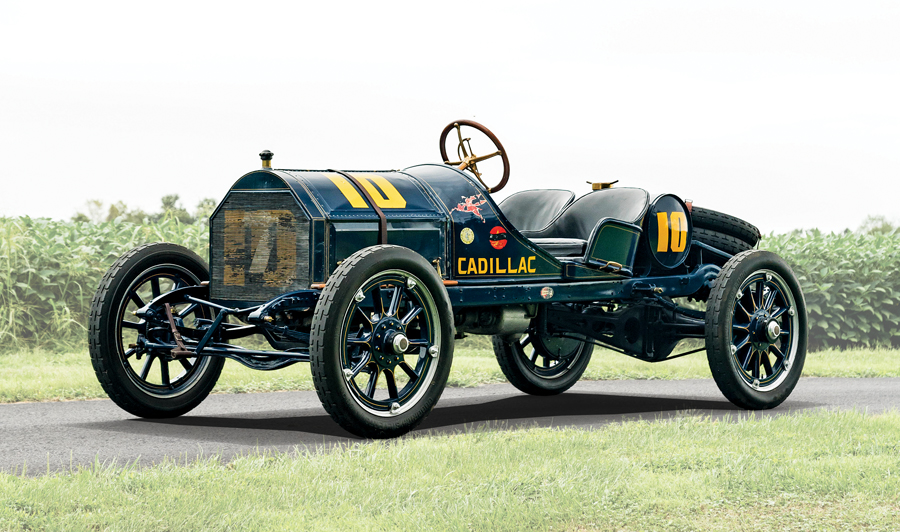SCM Analysis
Detailing
| Vehicle: | 1910 Cadillac racer |
| Years Produced: | 1910 (chassis and engine) |
| Number Produced: | 1 |
| Original List Price: | $1,600 (Model 30) |
| SCM Valuation: | $56,000 (this car) |
| Tune Up Cost: | $2,000 (if you can find parts) |
| Engine Number Location: | Top of crankcase |
| Club Info: | Antique Automobile Club of America |
| Website: | www.aaca.org |
| Alternatives: | 1910 Marmon Wasp, 1910 Locomobile, 1910 National |
| Investment Grade: | D |
This car, Lot 120, sold for $56,000, including buyer’s premium, at Bonhams’ Simeone Foundation Automotive Museum sale in Philadelphia, PA, on October 8, 2018.
The early history of the Cadillac Automobile Company is certainly a question of “what if.” If Henry Leland had not been asked to appraise the Henry Ford Company for sale and liquidation, Cadillac may never have happened. And if Oldsmobile had not turned down Henry Leland’s improved engine that produced three times the power of the Olds mill, again, Cadillac may never have happened.
Building it better
Henry Leland was a precise engineer whose acumen was precise gear making. He had developed and refined the process of manufacturing interchangeable gears built to a tight tolerance. His company, Leland & Faulconer, known as L&F, was building gears for Pope, Pierce-Arrow and other bicycle firms of the day. They evolved into steam and combustion engines and were granted a contract for 2,000 engines for Olds. Leland, as an experiment, “hot-rodded” an engine, and it produced three times the power that Olds required, but they were too busy to delay production for any possible change-over.
When Leland appraised the Henry Ford Company — Ford had already left the firm — he suggested that rather than liquidate, they reorganize and manufacture automobiles utilizing the engine that Olds had rejected.
The rest is history, as the Model A Cadillac, with L&F supplying the engines, transmission and steering gears, was first exhibited at the January 1903 New York Auto Show. With 2,287 orders, it was declared “sold out.”
While other automotive manufacturers proved their mettle with racing accomplishments, Cadillac made their reputation with mechanical excellence.
Due to the extremely tight tolerances, Cadillac’s parts were totally interchangeable. This was emphasized in 1908 when Cadillac won the prestigious Dewar Trophy — the first American car manufacturer to do so. It was a result of their having won the Royal Automobile Club Standardization Test, when three runabouts were disassembled, 90 factory parts substituted and the cars re-assembled. They then ran 500 miles around Brooklands. Their reputation was secure.
One of none
The 1910 Cadillac race car that was sold by Bonhams is a racer that might have been. As noted in the auction description, it was not a vehicle produced by Cadillac. It may have been built in the ’50s, but there is nothing definitive to prove that. Racing was certainly in vogue at the time, and the body is period-correct. It was mounted on a 1910 chassis with a 226-ci inline-4 motor, which was correct for 1910, and the engine number falls in the correct sequence. It is also fitted with Cadillac’s self-starter, which was introduced in 1912.
The development of the self-starter was a priority for Cadillac after Leland’s friend was killed with a crank handle. Charles Kettering had developed an electronic ignition, and with an order for 8,000 units, he formed Dayton Engineering Laboratories Company, or Delco. They were also working on a self-starter, and it is a matter of discussion as to how much of the Delco design was utilized. They were, however, given a contract to produce 5,000 self-starters for Cadillac.
The self-starter on this car is obviously not period-correct, and neither is the Mobil Pegasus decal. The Vacuum Oil Corporation trademarked the Pegasus in 1911 through a subsidiary in Cape Town, South Africa. It was white on a red background and was adopted, in red, as a trademark for Socony-Vacuum in 1931.
Veteran or curiosity?
The question is, what do we do with this racer that never was? It would be an interesting display piece for not a whole lot of money, but the questions will never end.
The auction description suggested it could be a candidate for Brass tours or the track, but not all events accept re-creations. It was certified in 1952 by the AAA as a veteran racer, so that may open a few doors. The new owner, I’m sure, has a plan, and I certainly hope he enjoys the Cadillac racer. I just don’t see how there is any financial return. Price paid was all the money for a car that never was.
(Introductory description courtesy of Bonhams.)
